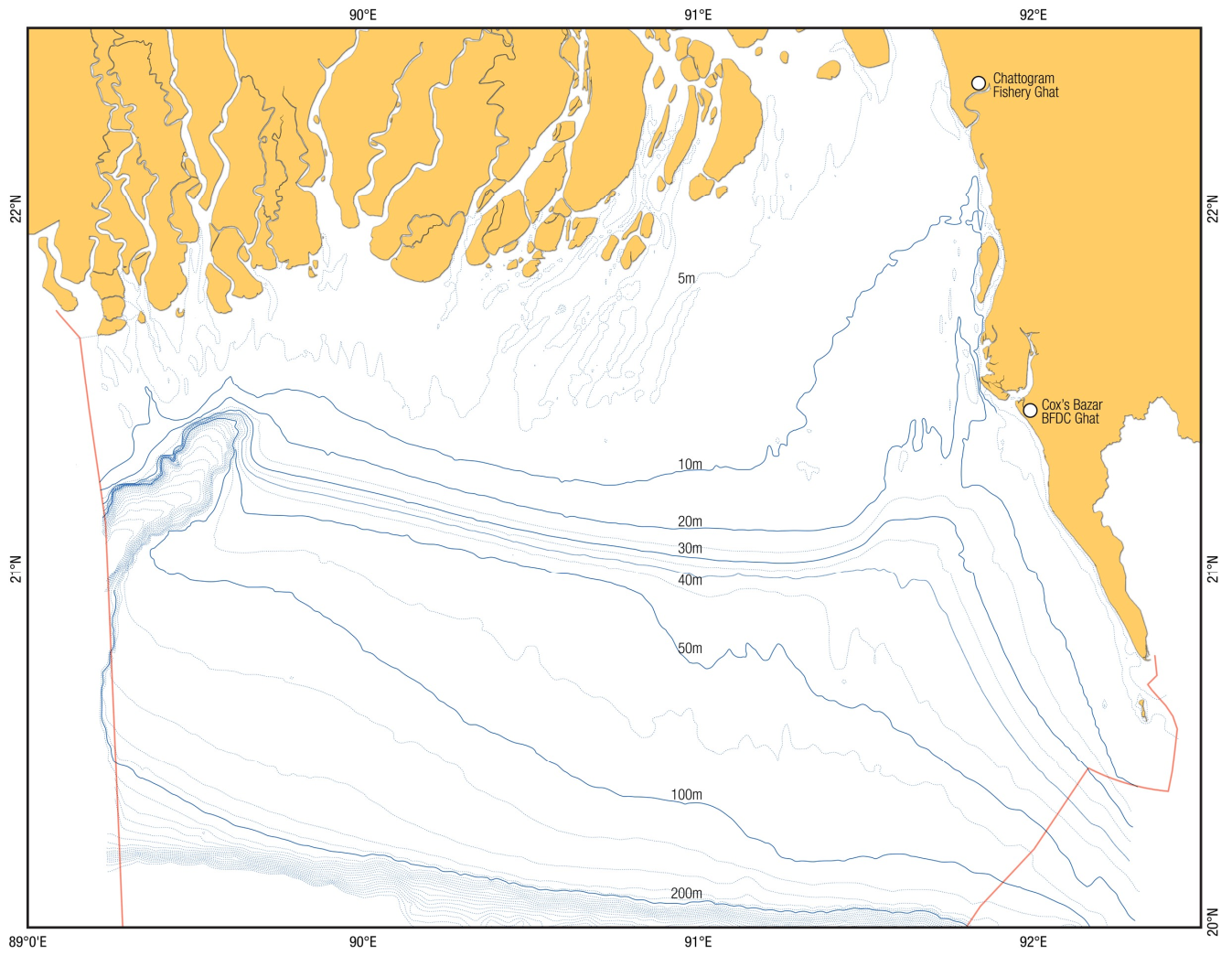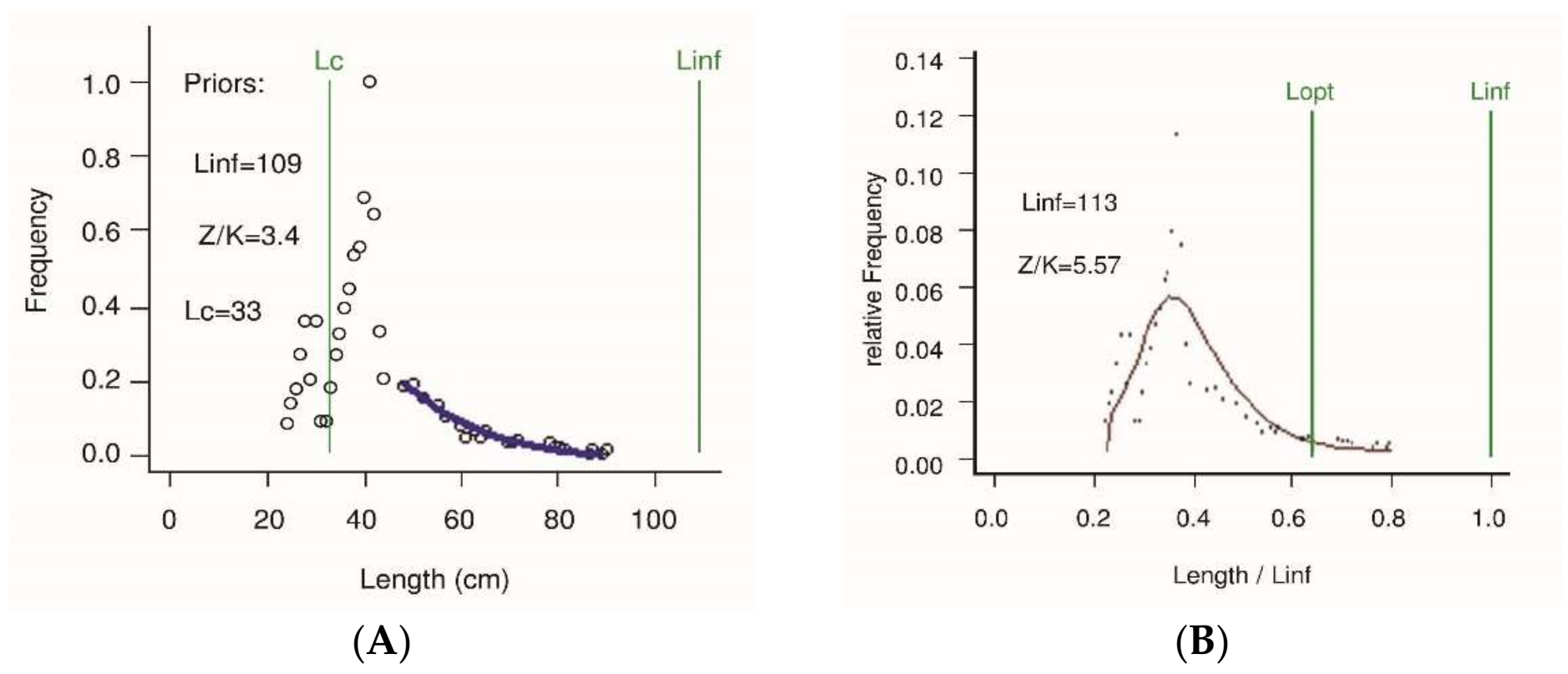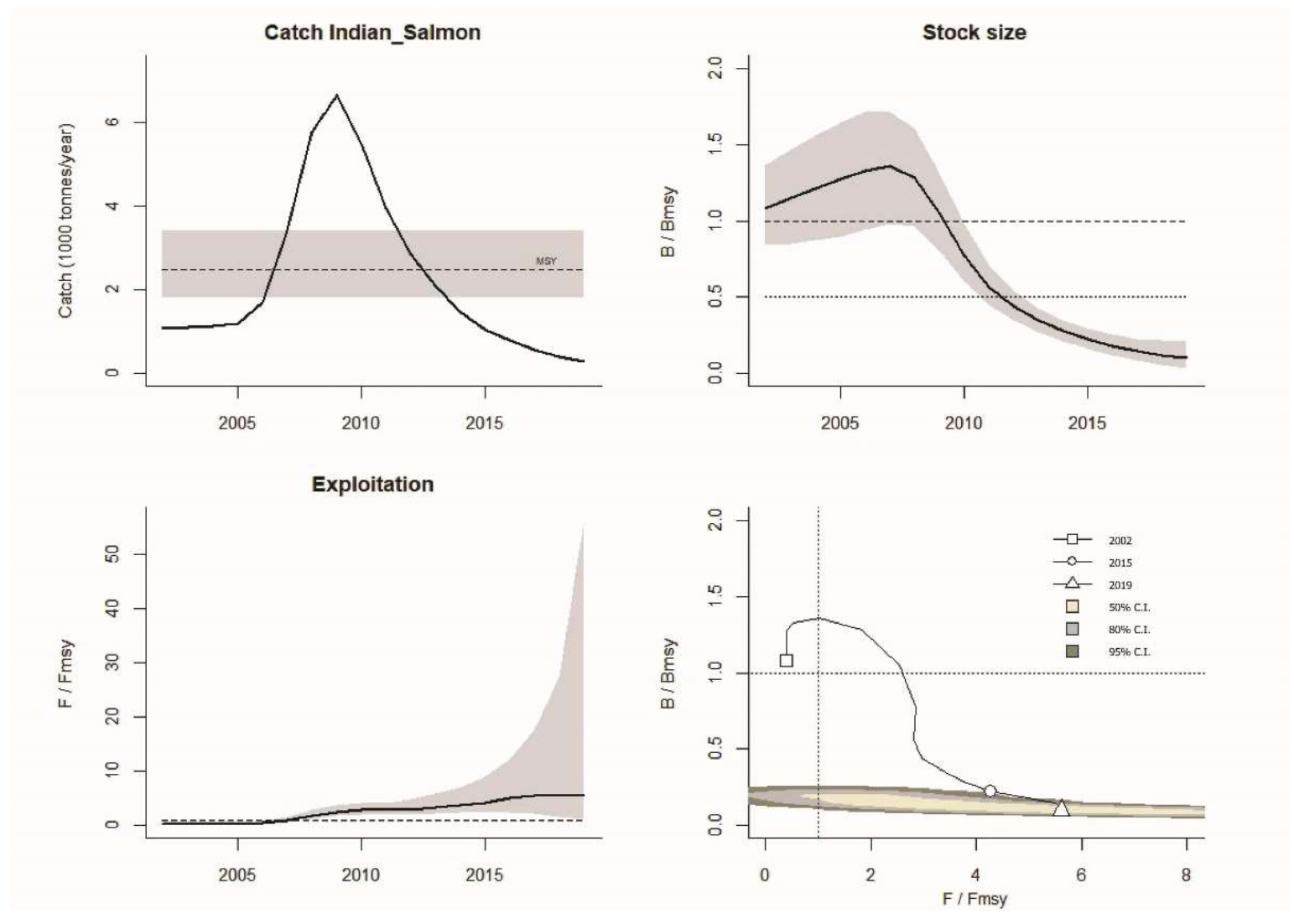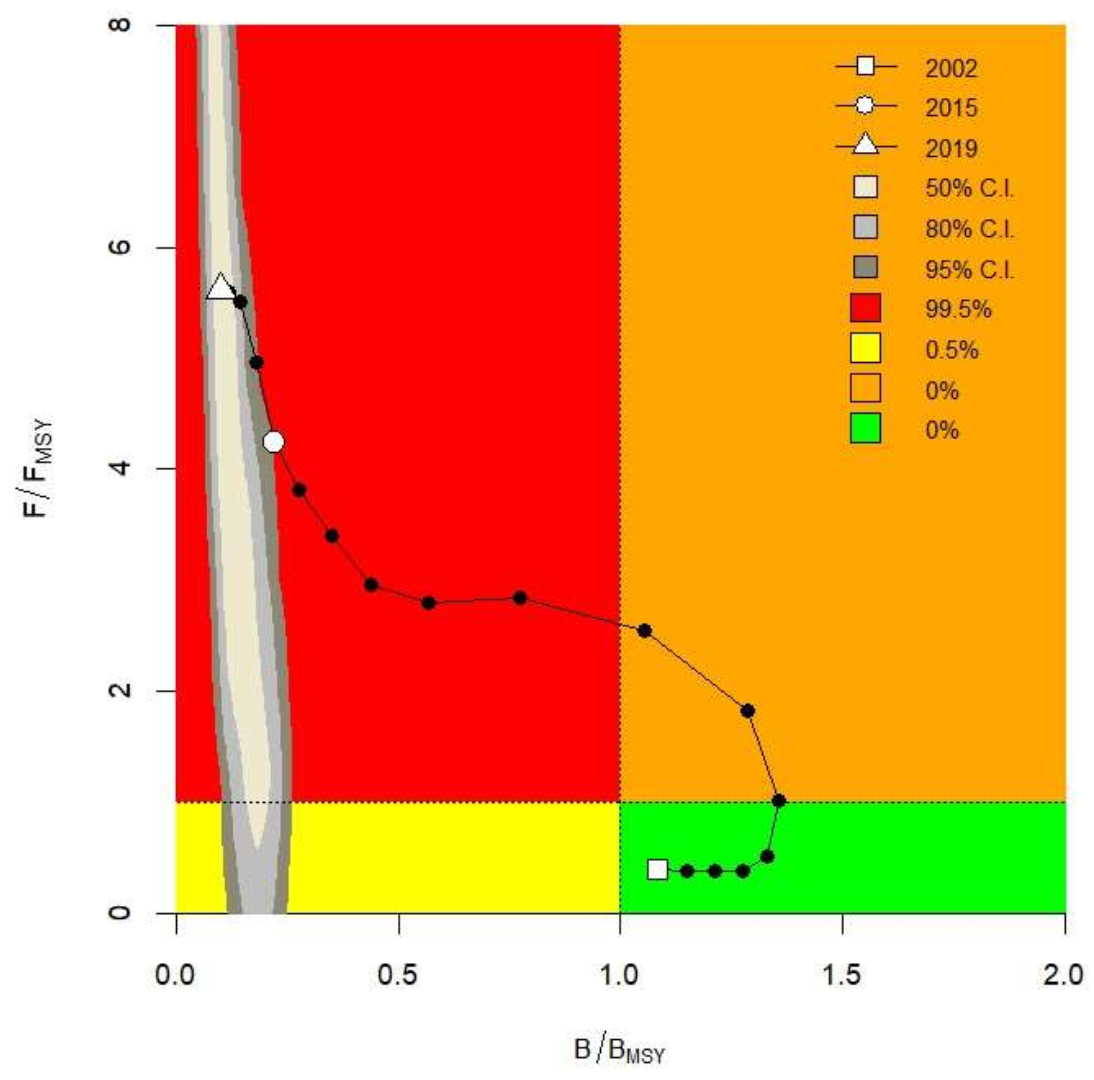Estimation of Stock Status Using the LBB and CMSY Methods for the Indian Salmon Leptomelanosoma indicum (Shaw, 1804) in the Bay of Bengal, Bangladesh
Abstract
:1. Introduction
2. Materials and Methods
2.1. Data Sources
2.2. Description of the LBB Method
2.3. Description of CMSY and BSM
3. Results
3.1. Parameters Produced by the LBB Approach
3.2. Fisheries Reference Points (BRPs) Produced from CMSY and BSM
4. Discussion
5. Conclusions
Author Contributions
Funding
Institutional Review Board Statement
Informed Consent Statement
Data Availability Statement
Acknowledgments
Conflicts of Interest
References
- Hilborn, R.; Walters, C.J. Quantitative fisheries stock assessment: Choice, dynamics and uncertainty. Rev. Fish Biol. Fish. 1992, 2, 177–178. [Google Scholar]
- Froese, R.; Demirel, N.; Coro, G.; Kleisner, K.M.; Winker, H. Estimating fisheries reference points from catch and resilience. Fish Fish. 2017, 18, 506–526. [Google Scholar] [CrossRef] [Green Version]
- Khatun, M.H.; Lupa, S.T.; Rahman, M.F.; Barman, P.P.; Liu, Q. Evaluation of Labeo calbasu fishery status using surplus production models in Kaptai reservoir, Bangladesh. Appl. Ecol. Environ. Res. 2019, 17, 2519–2532. [Google Scholar] [CrossRef]
- Ji, Y.; Liu, Q.; Liao, B.; Zhang, Q.; Han, Y.N. Estimating biological reference points for large head hairtail (Trichiurus lepturus) fishery in the Yellow Sea and Bohai Sea. Acta Oceanol. Sin. 2019, 38, 20–26. [Google Scholar] [CrossRef]
- Barman, P.P.; Karim, E.; Khatun, M.H.; Rahman, M.F.; Alam, M.S.; Liu, Q. Application of CMSY to estimate biological reference points of Bombay duck (Harpadon neherus) from the Bay of Bengal, Bangladesh. Appl. Ecol. Environ. Res. 2020, 18, 8023–8034. [Google Scholar] [CrossRef]
- Froese, R. Keep it simple: Three indicators to deal with overfishing. Fish Fish. 2004, 5, 86–91. [Google Scholar] [CrossRef] [Green Version]
- Hussain, M.G.; Hoq, M.E. (Eds.) Sustainable Management of Fisheries Resources of the Bay of Bengal. Support to Sustainable Management of the BOBLME Project; Bangladesh Fisheries Research Institute: Mymensingh, Bangladesh, 2010; Available online: https://www.researchgate.net/profile/M_G_Hussain/publication/283509739_Sustainable_Management_of_Fisheries_Resources_of_the_Bay_of_Bengal/links/563c7f9a08ae405111a9d6ca/Sustainable-Management-of-Fisheries-Resources-of-the-Bay-of-Bengal.pdf (accessed on 22 June 2021).
- Martell, S.; Froese, R. A simple method for estimating MSY from catch and resilience. Fish Fish. 2013, 14, 504–514. [Google Scholar] [CrossRef]
- Islam, S. Perspectives of the coastal and marine fisheries of the Bay of Bengal, Bangladesh. Ocean Coast. Manag. 2003, 46, 763–796. [Google Scholar] [CrossRef]
- Hossain, S. Biological aspects of the coastal and marine environment of Bangladesh. Ocean Coast. Manag. 2001, 44, 261–282. [Google Scholar] [CrossRef]
- Murshed-e-Jahan, K.; Belton, B.; Viswanathan, K.K. Communication strategies for managing coastal fisheries conflicts in Bangladesh. Ocean Coast. Manag. 2014, 92, 65–73. [Google Scholar] [CrossRef] [Green Version]
- Motomura, H.; Iwatsuki, Y. A new genus, Leptomelanosoma, for the polynemid fish previously known as Polydactylus indicus (Shaw, 1804) and a redescription of the species. Ichthyol. Res. 2001, 48, 13–21. [Google Scholar] [CrossRef]
- DoF (Department of Fisheries). Yearbook of Fisheries Statistics of Bangladesh, 2019–2020; Department of Fisheries, Ministry of Fisheries and Livestock, Government of Bangladesh: Dhaka, Bangladesh, 2020; Volume 37. [Google Scholar]
- Smith, J.L.B. The Sea Fishes of Southern Africa; Central News Agency Ltd.: Cape Town, South Africa, 1949. [Google Scholar]
- Menon, A.G.K.; Babu Rao, M. Polynemidae. In FAO Species Identification Sheets for Fishery Purposes—Western Indian Ocean (Fishing Area 51); Fischer, W., Bianchi, G., Eds.; FAO: Rome, Italy, 1984; Volume 3, pp. 1–2. [Google Scholar]
- Menon, A.G.K. Polynemidae. In FAO Species Identification Sheets for Fishery Purposes—Eastern Indian Ocean and Western Central Pacific (Fishing Area 57 and 71); Fischer, W., Whitehead, P.J.P., Eds.; FAO: Rome, Italy, 1974; Volume 3, pp. 1–2. [Google Scholar]
- Shamsuzzaman, M.M.; Islam, M.M.; Tania, N.J.; Abdullah Al-Mamun, M.; Barman, P.P.; Xu, X. Fisheries resources of Bangladesh: Present status and future direction. Aquac. Fish. 2017, 2, 145–156. [Google Scholar] [CrossRef]
- Fanning, P.; Chowdhury, S.R.; Uddin, M.S.; Al-Mamun, M.A. Marine Fisheries Survey Reports and Stock Assessment 2019; Bangladesh Marine Fisheries Capacity Building Project, Department of Fisheries, Ministry of Fisheries and Livestock: Dhaka, Bangladesh, 2019. Available online: http://mfsmu.fisheries.gov.bd/site/download/03cb42dc-8a4f-4dd3-a08943e5f5bcf61b (accessed on 22 June 2021).
- Hussain, M.G.; Rahman, M.J. Marine Fisheries Resources of Bangladesh: Stock Status and Management Issues. Sustainable Management of Fisheries Resources of the Bay of Bengal; Support to BOBLME Project; Bangladesh Fisheries Research Institute: Mymensingh, Bangladesh, 2010; pp. 37–51. Available online: http://www.boblmebangladesh.org/SBOBLME%20Publications/1.Sustainable%20management%20of%20fisheries%20resources%20of%20the%20BoB.pdf#page=44 (accessed on 5 January 2022).
- Schaefer, M.B. Some aspects of the dynamics of populations important to the management of the commercial marine fisheries. Int.-Am. Trop. Tuna Comm. Bull. 1954, 1, 23–56. [Google Scholar] [CrossRef]
- Pauly, D.; Morgan, G.R. Length-Based Methods in Fisheries Research; World Fish: Penang, Malaysia, 1987. [Google Scholar]
- Liang, C.; Pauly, D. Growth and mortality of exploited fishes in China’s coastal seas and their uses for yield-per-recruit analyses. J. Appl. Ichthyol. 2017, 33, 746–756. [Google Scholar] [CrossRef]
- Liang, C.; Xian, W.; Liu, S.; Pauly, D. Assessments of 14 exploited fish and invertebrate stocks in Chinese waters using the LBB method. Front. Mar. Sci. 2020, 7, 314. [Google Scholar] [CrossRef]
- Froese, R.; Winker, H.; Coro, G.; Demirel, N.; Tsikliras, A.C.; Dimarchopoulou, D.; Scarcella, G.; Probst, W.N.; Dureuil, M.; Pauly, D. A Simple User Guide for LBB (LBB_33a.R). 2019. Available online: http://oceanrep.geomar.de/44832/ (accessed on 23 June 2021).
- Froese, R.; Demirel, N.; Gianpaolo, C.; Winker, H.; A Simple User Guide for CMSY+ and BSM (CMSY_2019_9f.R). December 2019. Available online: https://oceanrep.geomar.de/33076/ (accessed on 23 June 2021).
- Plummer, M. JAGS: A program for analysis of Bayesian graphical models using Gibbs sampling. In Proceedings of the 3rd International Workshop on Distributed Statistical Computing, Vienna, Austria, 20–22 March 2003; Volume 124, pp. 1–10. [Google Scholar]
- Froese, R.; Winker, H.; Coro, G.; Demirel, N.; Tsikliras, A.C.; Dimarchopoulou, D.; Scarcella, G.; Probst, W.N.; Dureuil, M.; Pauly, D. A new approach for estimating stock status from length frequency data. ICES J. Mar. Sci. 2018, 75, 2004–2015. [Google Scholar] [CrossRef]
- Palomares, M.L.D.; Froese, R. Training on the use of CMSY for the assessment of fish stocks in data-poor environments. In Workshop Report Submitted to the GIZ by Quantitative Aquatics, Inc. Q-Quatics; Technical Report No. 2; Quantitative Aquatics, Inc.: Laguna, Philippines, 2017; pp. 4–16. [Google Scholar]
- Froese, R.; Pauly, D. Fishbase. Available online: https://fishbase.mnhn.fr/search.php (accessed on 5 January 2022).
- Ricker, W.E. Computation and interpretation of biological statistics of fish populations. Bull. Fish. Res. Board Can. 1975, 191, 1–382. [Google Scholar] [CrossRef]
- Haddon, M. Modelling and Quantitative Methods in Fisheries, 2nd ed.; Chapman and Hall/CRC: Boca Raton, FL, USA, 2011. [Google Scholar] [CrossRef]
- Carruthers, T.R.; Punt, A.; Walters, C.J.; MacCall, A.; McAllister, M.K.; Dick, E.J.; Cope, J. Evaluating methods for setting catch limits in data-limited fisheries. Fish. Res. 2014, 153, 48–68. [Google Scholar] [CrossRef] [Green Version]
- Froese, R.; Pauly, D. Fishbase. Version (02/2015) Worldwide Web Electronic Publication. Available online: http://www.fishbase.org (accessed on 15 November 2021).
- MacCall, A.D. Depletion-corrected average catch: A simple formula for estimating sustainable yields in data-poor situations. ICES J. Mar. Sci. 2009, 66, 2267–2271. [Google Scholar] [CrossRef]
- Dick, E.; MacCall, A.D. Depletion-based stock reduction analysis: A catch-based method for determining sustainable yields for data-poor fish stocks. Fish. Res. 2011, 110, 331–341. [Google Scholar] [CrossRef]
- Palomares, M.L.D.; Froese, R.; Derrick, B.; Nöel, S.-L.; Tsui, G.; Woroniak, J.; Pauly, D. A preliminary global assessment of the status of exploited marine fish and invertebrate populations. In A Report Prepared by the Sea around Us for OCEANA; The University of British Columbia: Vancouver, BC, Canada, 2018. [Google Scholar]
- Ghosh, S.; Muktha, M.; Rao, M.H.; Behera, P.R. Assessment of stock status of the exploited fishery resources in northern Bay of Bengal using landed catch data. Indian J. Fish. 2015, 62, 23–30. Available online: https://www.researchgate.net/profile/Pralaya-Behera/publication/289196671_Assessment_of_stock_status_of_the_exploited_fishery_resources_in_northern_Bay_of_Bengal_using_landed_catch_data/links/568a326b08ae1975839d67fd/Assessment-of-stock-status-of-the-exploited-fishery-resources-in-northern-Bay-of-Bengal-using-landed-catch-data.pdf (accessed on 9 January 2022).
- Chuenpagdee, R.; Morgan, L.E.; Maxwell, S.M.; Norse, E.A.; Pauly, D. Shifting gears: Assessing collateral impacts of fishing methods in US waters. Front. Ecol. Environ. 2003, 1, 517–524. [Google Scholar] [CrossRef]
- Gattuso, J.-P.; Magnan, A.K.; Bopp, L.; Cheung, W.W.L.; Duarte, C.M.; Hinkel, J.; McLeod, E.; Micheli, F.; Oschlies, A.; Williamson, P.; et al. Ocean solutions to address climate change and its effects on marine ecosystems. Front. Mar. Sci. 2018, 5, 337. [Google Scholar] [CrossRef] [Green Version]




| Scientist Name | Common Name | Min (cm) | Max (cm) | Class Interval | Numbers | Linf Prior (cm) | Z/K Prior | M/K Prior | F/K Prior | Lc Prior | Alpha Prior |
|---|---|---|---|---|---|---|---|---|---|---|---|
| Leptomelanosoma indicum | Indian Salmon | 24 | 91 | 1 | 978 | 109 | 3.4 | 1.5 | 1.89 | 33.7 | 26.4 |
| Resilience | High | Medium | Low | Very Low |
|---|---|---|---|---|
| Prior r range | 0.6–1.5 | 0.2–0.8 | 0.05–0.5 | 0.015–0.1 |
| Very Strong Depletion | Strong Depletion | Medium Depletion | Low Depletion | Nearly Unexploited |
|---|---|---|---|---|
| 0.01–0.2 | 0.01–0.4 | 0.2–0.6 | 0.4–0.8 | 0.75–1.0 |
| Input Parameters | Prior Initial Relative Biomass | Prior Intermediate Relative Biomass | Prior Final Relative Biomass | Prior Range for r | Prior Range of q | Prior Range for k |
|---|---|---|---|---|---|---|
| Ranges of the values | 0.4–0.8 | 0.01–0.4 In year (2015) | 0.01–0.1 | 0.2–0.8 | 1.54 × 10−06–6.16 × 10−06 | 26,600–79,800 |
| Scientist Name | Lmean/Lopt | Lc/Lc_opt | L95th/Linf | B/B0 | B/BMSY | F/M | F/K | Z/K | Assessment |
|---|---|---|---|---|---|---|---|---|---|
| Leptomelanosoma indicum | 0.61 | 0.53 | 0.81 | 0.10 | 0.28 | 2.3 | 3.9 | 5.5 | Grossly overfished |
| BRPs | r (/yr) | F (/yr) | FMSY (/yr) | B (t) | BMSY (t) | F/FMSY | B/BMSY | MSY (t) |
|---|---|---|---|---|---|---|---|---|
| BSM | 0.32 (0.19–0.54) | 0.17 | 0.03 | 1620 | 15,600 | 5.66 | 0.11 | 2490 (1820–3410) |
Publisher’s Note: MDPI stays neutral with regard to jurisdictional claims in published maps and institutional affiliations. |
© 2022 by the authors. Licensee MDPI, Basel, Switzerland. This article is an open access article distributed under the terms and conditions of the Creative Commons Attribution (CC BY) license (https://creativecommons.org/licenses/by/4.0/).
Share and Cite
Al-Mamun, M.A.; Shamsuzzaman, M.M.; Schneider, P.; Mozumder, M.M.H.; Liu, Q. Estimation of Stock Status Using the LBB and CMSY Methods for the Indian Salmon Leptomelanosoma indicum (Shaw, 1804) in the Bay of Bengal, Bangladesh. J. Mar. Sci. Eng. 2022, 10, 366. https://doi.org/10.3390/jmse10030366
Al-Mamun MA, Shamsuzzaman MM, Schneider P, Mozumder MMH, Liu Q. Estimation of Stock Status Using the LBB and CMSY Methods for the Indian Salmon Leptomelanosoma indicum (Shaw, 1804) in the Bay of Bengal, Bangladesh. Journal of Marine Science and Engineering. 2022; 10(3):366. https://doi.org/10.3390/jmse10030366
Chicago/Turabian StyleAl-Mamun, Md. Abdullah, Md. Mostafa Shamsuzzaman, Petra Schneider, Mohammad Mojibul Hoque Mozumder, and Qun Liu. 2022. "Estimation of Stock Status Using the LBB and CMSY Methods for the Indian Salmon Leptomelanosoma indicum (Shaw, 1804) in the Bay of Bengal, Bangladesh" Journal of Marine Science and Engineering 10, no. 3: 366. https://doi.org/10.3390/jmse10030366
APA StyleAl-Mamun, M. A., Shamsuzzaman, M. M., Schneider, P., Mozumder, M. M. H., & Liu, Q. (2022). Estimation of Stock Status Using the LBB and CMSY Methods for the Indian Salmon Leptomelanosoma indicum (Shaw, 1804) in the Bay of Bengal, Bangladesh. Journal of Marine Science and Engineering, 10(3), 366. https://doi.org/10.3390/jmse10030366









